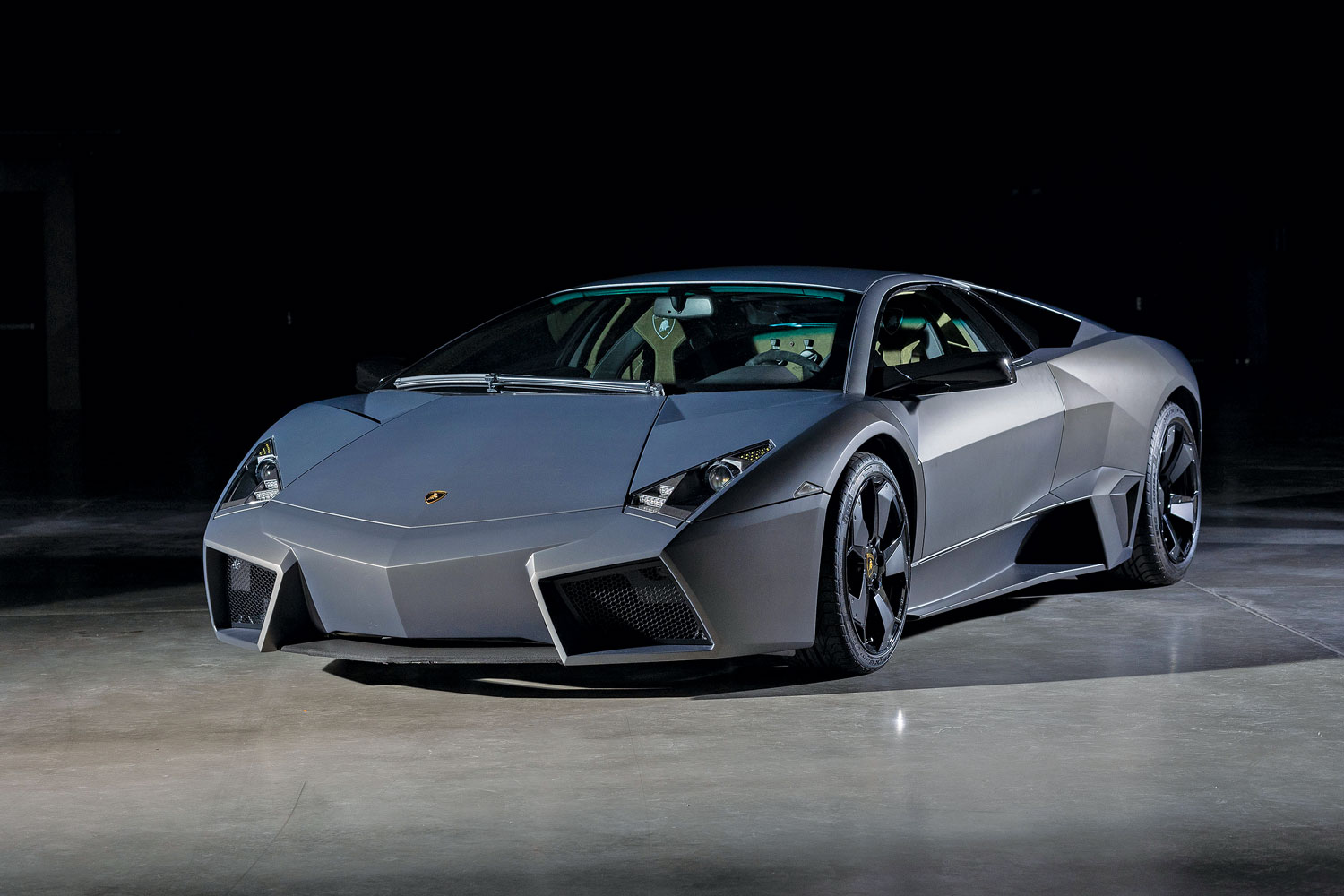When the Lamborghini Reventón launched at the 2007 Frankfurt Motor Show, it epitomized the ambition of the marque’s Centro Stile division. Production of the Reventón was capped at 20 models and, in the spirit of the long-standing tradition at Lamborghini, it was named after a fighting bull, although its name also suitably translates as “small explosion” in Spanish.
To arm the Reventón with power befitting its name, Lamborghini installed a 6.5-liter engine derived from its Murciélago LP 640-4 sister model. The quad-cam, 48-valve V12 could propel the car to 100 km/h in 3.4 seconds, while the Reventón would not stop accelerating until hitting a top speed of 340 km/h. The Reventón’s futuristic design language would later become apparent in both Aventador and Huracán models, while every example was clad in the same satin grey finish over angular bodywork made entirely from carbon fiber. Intricate details such as the individual carbon fiber and LED light clusters were industry firsts and set it far apart from series production cars, while the Alcoa-forged wheels featured angular carbon-fiber blade sections to tie them into the bodywork and simultaneously improve the brake cooling.
The aeronautical theme is carried into the cabin, where the LCD instrument cluster conveys vital information in a format reminiscent of that in a fighter jet, with two screens displaying sets of converging lines that display speed and rpm with a wing-style indicator between each. Sitting atop the two screens is a third screen, capable of displaying the level of g-force being exerted on the driver. It is entirely unique and widely considered to be one of the most evocative instrument clusters ever installed in a road legal car.
This particular car is numbered 13 of the 20 made and was delivered on September 29, 2008, via Lamborghini Chemnitz in Germany. It has been owned by the same individual since new as part of a collection, and is presented with just 106 kilometers on its odometer at the time of cataloging. The Reventón was serviced in 2008 and 2009 by the Lamborghini Centre in Chemnitz and in July 2022 by Lamborghini München. It is accompanied by its manuals in the correct numbered Reventón Air Force-style bag, numbered presentation key box with numbered Reventón folding knife, numbered key ring and car cover.
This is perhaps an unrepeatable opportunity to acquire what amounts to a nearly new example of one of the most exclusive Lamborghinis ever built.
SCM Analysis
Detailing
| Vehicle: | 2008 Lamborghini Reventón |
| Years Produced: | 2008–10 |
| Number Produced: | 20 coupes, 15 Roadsters |
| Tune Up Cost: | $600 |
| Chassis Number Location: | Plate on right-hand side of engine bay, tag on left-lower side of windshield |
| Engine Number Location: | Stamped on underside of bellhousing where engine joins transmission |
| Club Info: | Lamborghini Club America |
| Website: | http://www.lamborghiniclubamerica.com |
| Alternatives: | 2009–12 Aston Martin One-77, 2005–15 Bugatti Veyron, 2009 Mercedes-Benz SLR McLaren 722 S Roadster |
This car, Lot 133, sold for $1,814,328 (€1,748,750), including buyer’s premium, at RM Sotheby’s Munich, Germany, auction on November 26, 2022.
Long before Lamborghini spawned limited runs of genetically sensational progeny — the Sesto Elemento, Veneno, Centenario, etc. — it dropped a doozy of a Murciélago offshoot at the 2007 Frankfurt Motor Show. Just ahead of its debut, I had the opportunity to test a Reventón prototype in the hills surrounding Bologna, witnessing the gob-smacked reactions of native Italians while threading the seven-figure, 650-horsepower supercar through narrow mountain passes.
That particular vehicle (technically number 0 of 20) later landed in Lamborghini’s museum in Sant’Agata Bolognese following a marketing tour, testimony to the carbon-bodied coupe’s exceptionalism. Fifteen even-more-powerful Roadster variants debuted two years later, upping the coupe’s $1.3m price tag to $1.6m (rumored to be further escalated to $2.1m due to demand).
Born from jets
My firsthand experience with the Reventón puts the now 16-year-old supercar into a curious perspective. Originally said to be inspired by fighter jets, the model has since been dismissed by some as a mere re-skinning of the Murciélago. (It even featured that model name on its factory build tag.) It has certainly not achieved the esteem of other Lamborghini range-toppers, such as the Miura or Countach. However, at launch, the Reventón’s planar surfaces, faceted edges and rectilinear silhouette introduced a shocking new dialect into Lamborghini’s design language.
Dedicated aficionados could order the special model in any color, so long as it was Grigio Reventón, and the theme of military rigor extended into the then-innovative TFT cockpit-style display and carbon-fiber body panels. The accessories which accompanied the car included a military-inspired shoulder bag and numbered pocketknife. Customer interest was such that the small run of cars sold out almost immediately.
Successfully succeeded
That bit of period context is critical in quantifying the pricing roller coaster the Reventón has ridden since. For all its visual shock-and-awe, many of its sleek styling cues transferred into the carbon-chassis Aventador, which replaced the Murciélago in 2011. Mechanically superior to its predecessor in every way, the new flagship injected the Reventón’s details into an ambitiously futuristic package that was available at a much-reduced cost (about $390k at launch), helping propel Lamborghini to new sales heights.
The prism of history wasn’t as kind to the Reventón after its successor cannibalized much of its inspired, future-friendly styling. Still, during its brief reign, the Reventón legitimized Lamborghini as an innovator. It also helped pave the way for future big-dollar, small-batch spinoffs based on serially produced supercars.
The road ahead
The SCM Platinum Auction Database offers a telling insight into the rise, fall, and potential re-ascension of this low-volume model. The first Reventón transaction we recorded was on eBay in February 2009 (SCM# 119744), a coupe selling for an impressive $2.5m, or about $1m above MSRP. Note the critical pre-Aventador date, because the next Reventón to appear in our database wasn’t until 2015, when a 900-mile coupe sold at RM Sotheby’s Monterey auction for $1,375,000 (SCM# 6796786). The subsequent six offerings included no-sales at $1.02m and $1.5m, but those that did sell revealed an upward trend, including RM Sotheby’s $1,952,000 sale of a coupe at Monterey last year (SCM# 6955586). That sale is particularly interesting, as adjusted for inflation, it’s about what this car cost when new.
There is, however, potential for further value gain for the model, especially as Aventador production winds down — as does Lamborghini’s production of pure internal-combustion powertrains. The new flagship Lamborghini will sport a hybridized V12. Its introduction should make the Reventón appear as more of a historical time piece and a key model in the development of brand’s modern-day identity.
Better with age
Our subject Reventón is an essentially new car. As with many late-model supercars, it appears to have been used mostly as a display piece but is said to have had a recent service.
As a limited-run model that only saw a total of 35 coupes and convertibles these do not trade hands too frequently. With heavyweight collectors such as Ralph Lauren counted among the original buyers, the opportunity to turn back time and put yourself among that group is certainly restricted. Add in the specter of inflation and this near-$2m sale may well look like a bargain in a few years. ♦
(Introductory description courtesy of RM Sotheby’s.)




